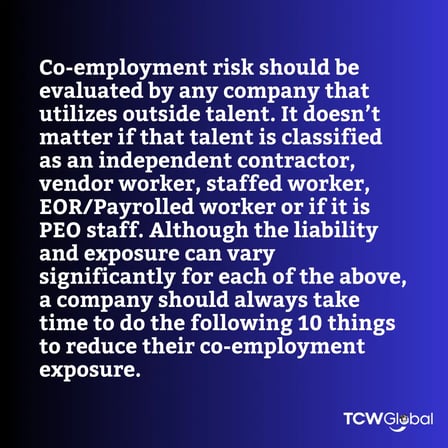Co-Employment is Alive and Well: 10 Things Each Company Should Do to Protect Themselves!
September 25, 2023

Co-employment risk should be evaluated by any company that utilizes outside talent. It doesn’t matter if that talent is classified as an independent contractor, vendor worker, staffed worker, EOR/Payrolled worker or if it is PEO staff. Although the liability and exposure can vary significantly for each of the above, a company should always take time to do the following 10 things to reduce their co-employment exposure.
Before we give you our 10 suggestions, we want to define the roles:
-
- Secondary Employer or Host Employer: This is typically the client company. They retain control over the day-to-day functions and activities of the individuals performing the work. This includes supervising the work, defining roles and responsibilities, and directing specific tasks. Essentially, this worksite employer manages the core job functions of the individual. This role benefits from the “work product”.
- Administrative Employer or Primary Employer: This is typically the agency, which cand include a staffing agency, talent agency, consulting firm, PEO or EOR/Payrolling Company. The administrative employer may handle tasks such as:
- Secondary Employer or Host Employer: This is typically the client company. They retain control over the day-to-day functions and activities of the individuals performing the work. This includes supervising the work, defining roles and responsibilities, and directing specific tasks. Essentially, this worksite employer manages the core job functions of the individual. This role benefits from the “work product”.
-
- Handling payroll and payroll tax compliance.
- Interviewing and identifying the talent and replacing them if needed.
- Providing employee benefits and managing benefits administration.
- Overseeing HR compliance, employee onboarding, and offboarding.
- Managing workers’ compensation claims and insurance.
- Addressing employment-related legal compliance and risk management.
The administrative employer doesn't direct the worker's daily tasks or activities related to the business's core functions but rather deals with the back-end and administrative elements of employment. the administrative employer may get involved in some day-to-day matters like workplace investigations.
By separating these roles, companies can focus on their primary business operations while leveraging the expertise and economies of scale that an agency provides. However, as with all business arrangements, it's crucial to clearly define and understand the respective roles and responsibilities to minimize potential complications or legal issues.
- Clear Contracts: Have a comprehensive contract with the vendor or staffing agency that delineates roles and responsibilities. Ensure that indemnification clauses are included, which can offer protection if one party fails to meet its obligations or if legal issues arise. Make sure anything you ask for is reasonable, a good partnership between the vendor and the client is crucial.
If you have a partner that is demanding blanket indemnification, you might want to walk away. A staffing agency or vendor IS NOT an insurance company. They should have adequate insurance coverage pertaining to workers on engagement with a company, but cannot necessarily agree to indemnify a client for actions outside of its control.
On the other hand, if an agency says don’t worry about co-employment and is unable to educate the company on how the contract allocates or mitigates those risks, the client may want to walk away. The contract should be win-win and reasonable. - Vet the Agency: Thoroughly research and vet any vendor or agency you plan to partner with. Ensure they have a solid reputation, are financially stable, and have a track record of legal and regulatory compliance. Make sure they have internal legal counsel and that they understand your questions about co-employment, liability, indemnification, roles and responsibilities etc.
Employment laws can be VERY complicated and having a partner that understands those will help protect your company and the workers that are serving as much needed resources. - Training: This can’t be overstated. Co-employment is easily thwarted by a well-meaning manager that uses the wrong language. Do not refer to workers as your “employees”. They ARE NOT your employees, they are workers on engagement with your company that are providing work product.
Provide proper training to your internal staff regarding the dynamics of the co-employment relationship, emphasizing the distinction in roles between the host employer and the staffing agency or vendor. Furthermore, Independent Contractors should not be called an employee or worst yet be categorized as such within your internal systems, including company emails, HRIS, or an ERP. - Maintain a Safe Work Environment: This helps everyone! If an individual suffers an on the job injury, they are going to look for anyone to accept liability and that may mean trying to create an employee-employer relationship for liability sake.
Making sure the Administrative Employer has proper coverage and is willing to provide a waiver of subrogation or an alternative employer endorsement is key. Make sure the agency takes good care of their workers, has good medical benefits, and contracts with a reputable workers compensation carrier. Ensure your workplace is safe, adheres to OSHA standards, and is free from harassment or discrimination. Regularly review and update your workplace policies. - Consistent Policies: It's important to document and create policies for each “type” of individual being engaged by the company. These classifications will provide clear guidelines for the company, internal managers, and set expectations with vendors. For example, who gets to attend the Annual Christmas Party?
- Temporary workers, contractors, vendor workers, independent contractors, highly paid consultants? This is just a small example. Document policies about each of the following for each classification: reporting hours, trainings, leave request, grievances, pay changes, SOW amendments, harassment complaints, early terms/contract changes etc. Share these policies with your vendors so there is clarify.
- Avoid Direct Involvement in Hiring and Firing: Allow the vendor/ agency to handle the recruitment, hiring, and, if necessary, the termination of workers. If the host employer feels a worker is not a good fit, they should communicate this to the agency and let the agency directly handle the termination process. By properly notify the employing agency prior to communicating the termination with the worker, you ensure the agency is set up to properly comply with final pay requirements, deprovisioning, and benefit management.
- Regular Communication: Maintain open lines of communication with the vendor. Regular check-ins can help address concerns before they become significant issues. With so much turn-over in today’s economy, there are going to be rogue workers and rogue vendors. Implement a hybrid MSP or VMS where you can have some visibility into your entire population of non FTE’s.
Make sure someone owns those vendor relationships. You might also save a significant sum of money by converting staffed workers to FTE’s or workers payrolled through an EOR after the conversion period. Also communicate any large layoffs to make sure any state or federal WARN acts are not triggered. - Insurance: Ensure that your company has appropriate liability insurance coverage and verify that the staffing agency or EOR also carries adequate insurance. Depending on the relationship, Employment Practices Liability Insurance (EPLI) might be beneficial, as it provides coverage against claims like wrongful termination, discrimination, or harassment. Most agencies will have sufficient coverage limits but confirm that this is in place. This applies not only to liability insurance, but for health insurance as well. Don’t short-change your workers or the company.
- Document Everything: Keep clear and thorough records of all interactions and decisions related to contractors and workers. Proper documentation can be invaluable if disputes or legal issues arise. If there is a wage change or role change, make sure your agency has a user-friendly system with a simple approval workflow and proper permissioning.
- Seek Legal Counsel: make sure you have good legal counsel that is very familiar with employment and co-employment laws. Domestically these laws can vary significantly from state to state and grow significantly more complex when you start expanding into global employment laws. A good starting place is finding a vendor that has experienced legal counsel and helpful resources, but having someone internally can give you the added assurance in what is being communicated.

Final Thoughts
Co-employment dynamics necessitate informed and proactive management. With the diverse types of external talent available to companies today, understanding and managing associated risks is paramount.
While the advantages of external staffing solutions can be numerous (from flexibility to expertise acquisition assistance) the potential legal and operational pitfalls must be adeptly navigated. Through strategies like solid contractual agreements, vigilant vetting processes, thorough training, and seeking expert legal counsel, companies can harness the benefits of external talent while effectively mitigating co-employment exposures.
At its core, fostering a transparent, communicative, and collaborative relationship with staffing agencies and vendors is the cornerstone of a successful and risk-averse co-employment partnership.
TCWGlobal has helped 1000's of companies with their co-employment strategies. Let's connect now, as a global employer of record, we specialize in helping companies manage their contingent workforce.
